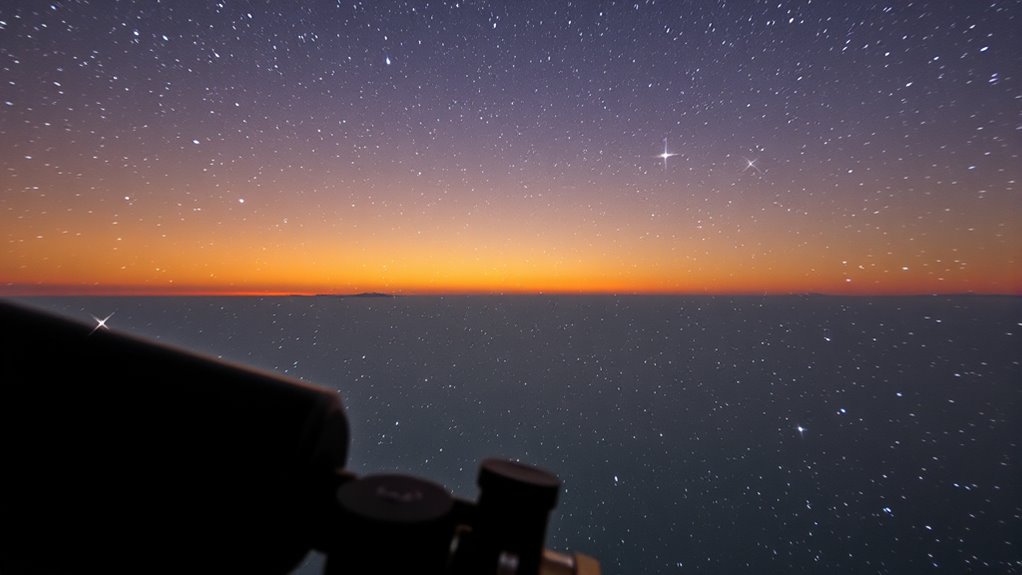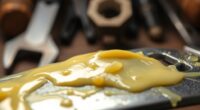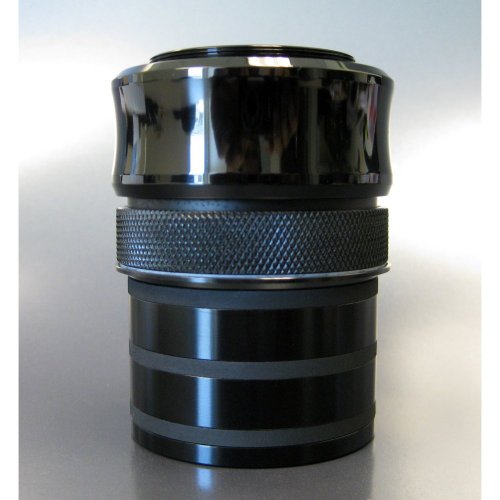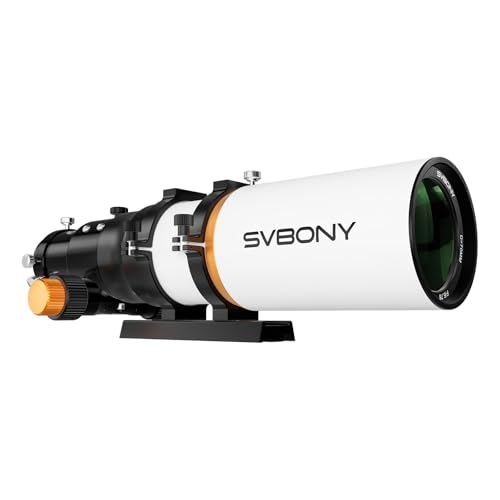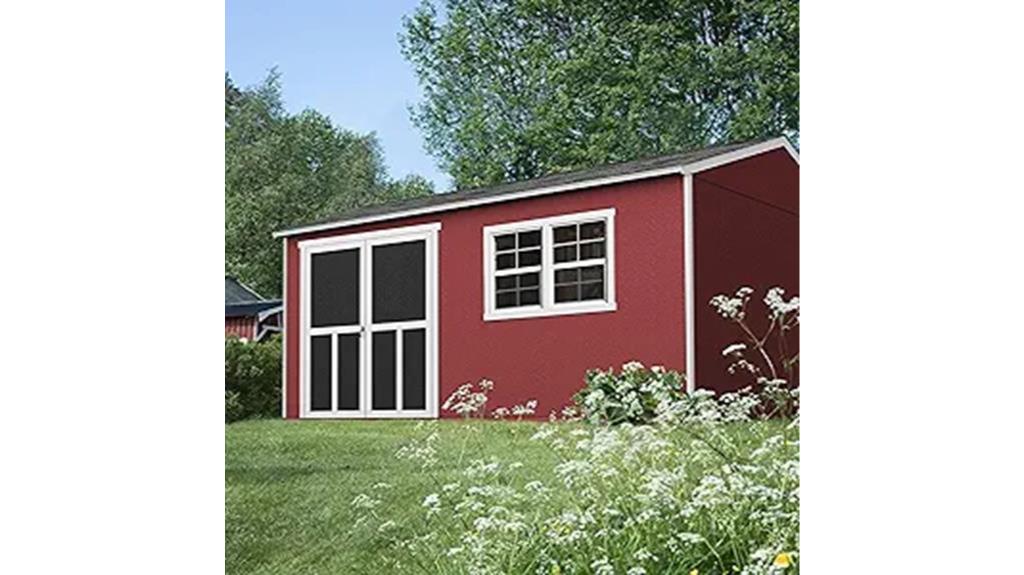If you’re looking for the best field flatteners for refractor telescopes that deliver sharp, clear images, I recommend options like the Explore Scientific Flattener, Astromania’s models, and SVBONY’s focal reducers. These devices minimize star distortion across wide fields, enhance contrast, and support various camera types. They’re compatible with focal ratios from f/4 to f/8 and fit different mounting threads. Keep exploring, and you’ll find detailed insights to help you choose the perfect flattening solution.
Key Takeaways
- Look for flatteners compatible with your telescope’s focal ratio (f/4 to f/8) to minimize star distortion.
- Choose models with high-quality, fully multi-coated ED or achromatic lenses for sharp, contrast-rich images.
- Ensure the flatener offers appropriate back focus distance (55mm–109mm) for proper focus and optimal performance.
- Select flatteners with versatile mounting options (M48, T-ring) and support for filters and accessories.
- Prioritize lightweight, durable designs with features like field rotators and dual-speed focusers for precise, stable imaging.
Explore Scientific Field Flattener for Refractor Telescopes
If you’re serious about capturing sharp, distortion-free astrophotos, the Explore Scientific Field Flattener is an excellent choice for refractor telescope users. It minimizes star distortion caused by field curvature, ensuring your images stay crisp across the entire frame. Designed for telescopes with f/5 to f/7 focal ratios, it requires about 55mm of spacing from your camera sensor for ideal results. The device features a secure T-ring attachment, compatible with various cameras. Fully multi-coated optical glass maximizes light transmission, delivering high-contrast images of planets, galaxies, and nebulae. Made in the USA, it offers reliable support and quality craftsmanship for dedicated astrophotographers.
Best For: astrophotographers using refractor telescopes with focal ratios between f/5 and f/7 seeking to achieve sharp, distortion-free images across their entire field of view.
Pros:
- Effectively minimizes star distortion caused by field curvature for clearer astrophotos
- Fully multi-coated optical glass enhances light transmission and image contrast
- Secure T-ring attachment allows compatibility with various camera models
Cons:
- Requires precise spacing of approximately 55mm from the camera sensor for optimal performance
- Designed specifically for f/5 to f/7 focal ratios, limiting use outside this range
- May be less suitable for non-refractor telescope types or setups outside the specified specifications
Astromania 2 Field Flattener for Astronomy Photos
The Astromania 2 Field Flattener is an excellent choice for astrophotographers using refractor telescopes with focal ratios between F4 and F8, as it effectively corrects field curvature to produce sharp, flat images across the entire frame. It features an M48 thread for full aperture illumination and 2 inches back focus, allowing room for accessories. Its multi-coated lenses enhance image clarity and contrast, while its compact size makes it portable and easy to handle. Although setup can be tricky and support may be unhelpful at times, many users have achieved excellent, distortion-free images with proper use. Overall, it’s a solid option for improving astrophotography results.
Best For: astrophotographers using refractor telescopes with focal ratios between F4 and F8 seeking to achieve sharp, flat images across their entire frame.
Pros:
- Corrects field curvature for fully flat, sharp images across the entire image field
- Multi-coated lenses improve image clarity and contrast
- Compact and lightweight design for portability and ease of handling
Cons:
- Setup can be complicated and may require trial and error
- Lack of included manual can make initial adjustments difficult
- Customer support has been reported as unhelpful at times
Astromania 2 Field Flattener for Astronomy Photos
Astromania’s 2 Field Flattener stands out as an ideal choice for astrophotographers seeking sharp, distortion-free images across their entire camera sensor. Compatible with refractors from f/4 to f/8, it guarantees perfect flatness, addressing field curvature common in astrophotography. Its M48 threading allows full aperture illumination, while the 109mm back focus provides ample room for accessories. With excellent multi-coating, it maximizes light transmission and reduces reflections, resulting in clearer, brighter images. Weighing just 8.8 ounces, it’s lightweight and easy to handle. Overall, this flattener delivers consistently sharp stars across the entire field, making it a reliable tool for high-quality astrophotos.
Best For: amateur and professional astrophotographers seeking sharp, distortion-free images across their entire camera sensor with refractor telescopes from f/4 to f/8.
Pros:
- Ensures perfect image flatness, reducing field curvature in astrophotography.
- Compatible with a wide range of refractor telescopes (f/4 to f/8) and offers full aperture illumination via M48 threading.
- Lightweight at only 8.8 ounces, making it easy to handle and install.
Cons:
- May require additional accessories or adapters for specific telescope models.
- Limited to telescopes within the f/4 to f/8 focal ratio range, not suitable for faster or slower systems.
- Availability and pricing can vary across different online and offline retailers.
SVBONY SV209 Field Flattener, 0.8X Focal Reducer for Telescopes
Designed specifically for astrophotographers using SV550 122mm f/7 APO refractors, the SVBONY SV209 Field Flattener 0.8X focal reducer enhances image quality by correcting field curvature and expanding the field of view. It converts the 854mm focal length (f/7) into 683.2mm (f/5.6), allowing for faster, wider shots. Its metal 63×1 thread easily screws into the focuser, providing a secure fit. Customers report that it delivers sharp, flat star fields across DSLR and CCD sensors, improving edge-to-edge clarity. While some variability exists with extension tubes, overall, it’s a reliable accessory that notably elevates astrophotography results.
Best For: astrophotographers using SV550 122mm f/7 APO refractors seeking to improve image flatness and expand their field of view for high-quality, wide-field astrophotography.
Pros:
- Effectively corrects field curvature, resulting in sharp, flat star fields across DSLR and CCD sensors
- Converts focal length from 854mm to 683.2mm, enabling faster, wider imaging (f/7 to f/5.6)
- Easy to install with secure screw-in 63×1 metric thread, ensuring stable attachment
Cons:
- Variability in extension tube lengths (55mm, 91.5mm, 103mm) can impact focus and image quality
- Precise backspacing is critical; improper setup may lead to suboptimal performance
- Some users report challenges with compatibility or achieving perfect focus depending on their specific setup
HOTECH SCA 2 Inch Field Flattener for Refractor Telescopes
If you’re serious about astrophotography with refractor telescopes, the HOTECH SCA 2 Inch Field Flattener stands out as a top choice. Designed for f/5 to f/8 models, it features a fully multi-coated two-element lens that guarantees bright, sharp images across the entire field. Its compatibility with standard 2″ filters and all 35mm T-rings makes it versatile and easy to integrate. The built-in T-adapter center load system simplifies camera alignment, providing precise centering with compression and rubber rings for ideal optical axis alignment. Overall, it offers reliable performance and excellent image quality for dedicated astrophotographers.
Best For: astrophotographers using refractor telescopes with focal ratios between f/5 and f/8 seeking sharp, flat-field images and easy camera alignment.
Pros:
- Fully multi-coated two-element lens ensures bright, sharp images across the entire field.
- Compatible with standard 2″ filters and all 35mm T-rings for versatile imaging setups.
- Built-in T-adapter center load system simplifies precise camera positioning and alignment.
Cons:
- Designed specifically for f/5 to f/8 refractors, limiting use with faster or slower focal ratios.
- Slightly premium price point may be a consideration for budget-conscious users.
- Limited customer reviews (three), which could affect confidence in long-term performance data.
SVBONY SV503 Refractor Telescope with Built-in Field Flattener
The SVBONY SV503 Refractor Telescope with Built-in Field Flattener stands out as an excellent choice for astrophotographers seeking sharp, distortion-free images across wide fields. Its integrated flat-field correction eliminates field curvature, providing crisp views of galaxies, nebulae, and star clusters. The scope’s F/6.78 focal ratio and 70mm aperture deliver bright, high-contrast images, while ED glass reduces chromatic aberration for true-to-life colors. The dual-speed focuser allows precise focusing, and the included 0.8x reducer broadens the field of view for large objects. Built with quality materials, it offers stability and ease of use, making it a versatile, value-packed option for both beginners and advanced users.
Best For: amateur astronomers and astrophotographers seeking a portable, high-quality refractor telescope with wide-field imaging capabilities and minimal chromatic aberration.
Pros:
- Excellent flat-field correction with integrated field flattener for distortion-free wide views
- Bright, sharp images with reduced chromatic aberration thanks to ED glass
- Solid build quality with user-friendly focusing mechanism and included accessories
Cons:
- Slight corner star distortion when using focal reducers, which may require post-processing
- Focal length and aperture limit deep-sky object detail compared to larger scopes
- May be less suitable for high-magnification planetary viewing without additional accessories
SVBONY SV503 Portable Telescope Tube
For astrophotographers seeking sharp, detailed images, the SVBONY SV503 Portable Telescope Tube delivers high-quality optics with an S-FPL51 ED glass element that virtually eliminates chromatic aberration. Its doublet air-spaced achromatic design with a 2-element objective produces crisp, high-contrast images perfect for both visual observation and astrophotography. The 2-inch rack and pinion RAP focuser offers precise control and can securely hold heavy photographic accessories. Compact and portable, this telescope tube is ideal for travel and outdoor use, making high-quality imaging accessible anywhere. Its sturdy construction and excellent optical performance make it a reliable choice for enthusiasts aiming for sharp, clear celestial images.
Best For: amateur and experienced astrophotographers seeking portable, high-quality optics for detailed celestial imaging and versatile observation.
Pros:
- High-quality S-FPL51 ED glass element virtually eliminates chromatic aberration for sharp images
- Doublet air-spaced achromatic design delivers high-contrast, detailed visuals
- 2-inch rack and pinion RAP focuser provides precise control and supports heavy photographic accessories
Cons:
- May be less suitable for beginners due to its advanced features and handling
- Limited aperture size could restrict deep-sky object viewing compared to larger telescopes
- Compact design may require additional accessories for extended astrophotography sessions
SVBONY SV503 Refractor Telescope, 102mm F7
Designed with astrophotographers in mind, the SVBONY SV503 Refractor Telescope offers high-quality optics and versatile features that make it an excellent choice for detailed celestial imaging. Its 102mm aperture and F7 focal ratio deliver bright, sharp images of planets, deep-sky objects, and terrestrial scenes. The doublet air-spaced achromatic lens with S-FPL51 ED glass reduces chromatic aberration, ensuring accurate color reproduction. Fully multi-coated optics maximize light transmission and contrast. The dual-speed focuser allows precise focus adjustments, while the 360° field rotator enables smooth framing during astrophotography. Its compact, durable design makes it ideal for both mobile and stationary observing setups.
Best For: amateur astrophotographers and serious stargazers seeking high-quality, portable optics for detailed celestial and terrestrial observation.
Pros:
- High-quality 102mm aperture with F7 focal ratio delivers bright, sharp images suitable for planetary and deep-sky imaging.
- Fully multi-coated optics and S-FPL51 ED glass reduce chromatic aberration and maximize light transmission for vibrant, detailed views.
- Dual-speed focuser and 360° field rotator allow precise adjustments and seamless framing during astrophotography sessions.
Cons:
- Slightly heavier and bulkier than smaller telescopes, which may affect portability for some users.
- Requires additional accessories for astrophotography, such as mounts and cameras, which can add to overall cost.
- May have a learning curve for beginners unfamiliar with advanced focusing and framing features.
SVBONY SV193 Focal Reducer 2 Inch 0.8X for Telescopes
You are trained on data up to October 2023. The SVBONY SV193 Focal Reducer 2 Inch 0.8X is a game-changer for astrophotography with refractor telescopes. It reduces focal length and flattens the field to produce sharp, detailed images at the edges, minimizing star distortion. Its 0.8x focal reduction shortens exposure times, making quick captures easier. The 2-inch front socket ensures easy attachment, while the M48 threaded back connects smoothly to full-frame cameras. Plus, the integrated filter thread lets you add light pollution or other filters. Overall, it’s an essential tool for achieving clearer, more professional astrophotos.
Best For: astrophotographers and amateur astronomers seeking to enhance image sharpness, reduce edge distortion, and shorten exposure times when using refractor telescopes.
Pros:
- Effectively reduces focal length and flattens the field for sharper images at the edges
- Compatible with standard 2-inch filters and full-frame cameras for versatile imaging options
- Shortens exposure times thanks to 0.8x focal reduction, enabling quicker astrophotography sessions
Cons:
- Designed primarily for refractor telescopes, limiting compatibility with other telescope types
- Requires precise threading and attachment, which may need careful handling for secure fit
- May add additional weight or length to the optical setup, potentially affecting balance
SVBONY SV260 2 Telescope Filter with SV503 Refractor Telescope
The SVBONY SV260 2 Telescope Filter paired with the SV503 Refractor Telescope stands out as an excellent choice for astrophotographers seeking precise color reproduction and enhanced image clarity. Its multi-bandpass design isolates specific wavelengths, capturing vibrant colors and details in galaxies and nebulae. The filter’s high transmittance, over 90%, guarantees minimal light loss and accurate celestial hues. Additionally, it effectively suppresses light pollution across six levels, making faint objects more visible even in urban settings. Combined with the flat-field, chromatic aberration-minimizing SV503 refractor, this setup delivers sharp, distortion-free images across the entire field of view, perfect for deep-sky imaging.
Best For: amateur and professional astrophotographers seeking precise color accuracy, high light transmittance, and effective light pollution suppression for deep-sky imaging.
Pros:
- Over 90% peak transmittance ensures maximum light throughput and vibrant color capture.
- Multi-bandpass design effectively isolates specific wavelengths, enhancing details of galaxies, nebulae, and nebulae.
- Superior light pollution suppression across six levels improves image quality in urban or light-polluted environments.
Cons:
- May require compatible filters and mounts for optimal performance, adding to initial setup costs.
- The filter’s multi-bandpass feature might limit its effectiveness for very broad-spectrum or wide-field imaging.
- Requires careful handling and calibration to maximize flat-field correction benefits across the entire field of view.
SVBONY SV220 Dual-Band Nebula Filter with SV503 70mm Refractor Telescope
If you’re serious about astrophotography of nebulae and want to improve image contrast even in light-polluted skies, the SVBONY SV220 Dual-Band Nebula Filter paired with the SV503 70mm Refractor Telescope is an excellent choice. This combo enhances contrast by reducing light pollution from moonlight and artificial sources, revealing more detail in emission and planetary nebulae. The SV503 telescope’s built-in field flattener ensures sharp, distortion-free images across the entire field of view, while its flat-field design and high-quality glass minimize chromatic aberration. Together, they deliver clear, true-to-life images with improved contrast, making it ideal for deep-sky astrophotography.
Best For: astrophotographers seeking to capture detailed images of nebulae and deep-sky objects in light-polluted environments with enhanced contrast and minimal aberrations.
Pros:
- Effectively reduces light pollution from moonlight and artificial sources, improving nebula visibility
- Built-in field flattener ensures sharp, distortion-free images across the entire field of view
- High-quality glass minimizes chromatic aberration, delivering true-to-life colors and sharp details
Cons:
- May require additional mounting accessories not included for optimal setup
- Filter and telescope are designed primarily for astrophotography, less suitable for visual observing
- Product availability begins May 10, 2025, which may require planning for early acquisition
SVBONY SV503 Refractor Telescope with Built-in Field Flattener and SV305C Pro Telescope Camera
For amateur and experienced astronomers seeking sharp, wide-field views, the SVBONY SV503 Refractor Telescope with its built-in field flattener stands out as an excellent choice. Its design eliminates field curvature, ensuring edge-to-edge clarity in both visual observation and astrophotography. With a 70mm aperture and F/6.78 focal ratio, it provides bright, detailed images of galaxies, nebulae, and star clusters. The use of ED glass minimizes chromatic aberration, delivering true-to-life colors. Paired with the SV305C Pro camera, which offers high sensitivity and low noise, this setup delivers crisp planetary and deep-sky images, making it ideal for enthusiasts wanting sharp, distortion-free views.
Best For: amateur and experienced astronomers seeking sharp, wide-field views and high-quality planetary and deep-sky imaging.
Pros:
- Built-in field flattener eliminates field curvature for edge-to-edge clarity
- ED glass minimizes chromatic aberration for true-to-life color reproduction
- High-sensitivity IMX662 camera with low noise and fast frame rates enhances planetary and astrophotography
Cons:
- 70mm aperture may limit brightness for very deep-sky imaging compared to larger telescopes
- Focal ratio of F/6.78 may require longer exposure times for some astrophotography applications
- The setup and calibration might be complex for complete beginners unfamiliar with astrophotography equipment
SVBONY SV193 Focal Reducer 2 Inch 0.8X Field Flattener
Astronomers seeking sharp, wide-field astrophotography will find the SVBONY SV193 Focal Reducer 2 Inch 0.8X Field Flattener an excellent choice, especially since it’s compatible with full-frame cameras and standard refractor telescopes. It reduces focal length by 20%, making it easier to capture expansive deep-sky objects while maintaining image sharpness across the field. Its design corrects field curvature, minimizing star distortion at the edges. The 2-inch front socket and M48 threading ensure straightforward attachment to various setups. Paired with compatible planetary cameras, it produces detailed, high-contrast images, perfect for both amateur and advanced astrophotographers aiming for clarity and wide coverage.
Best For: amateur and professional astronomers seeking wide-field, high-sharpness astrophotography with compatibility for full-frame cameras and standard refractor telescopes.
Pros:
- Reduces focal length by 20%, enabling easier capture of wide-field deep-sky objects.
- Corrects field curvature for sharper, flatter images across the entire field of view.
- Compatible with full-frame cameras and standard 2-inch refractor setups for versatile use.
Cons:
- May require precise alignment and setup to achieve optimal image quality.
- Compatibility limited to telescopes with standard 2-inch fittings and M48 threading.
- Slight reduction in focal length may not be suitable for users prioritizing maximum magnification.
Sky Watcher Evolux 62ED Reducer/Flattener (0.9X)
The Sky Watcher Evolux 62ED Reducer/Flattener (0.9X) stands out as an excellent choice for astrophotographers seeking sharp, flat images with their refractor telescopes. Its 62mm aperture and f/5.8 focal ratio deliver a 360mm focal length, ideal for wide-field astrophotography. The device includes one ED element, enhancing image quality, while the built-in rotator and filter cavity streamline filter use. With a 55mm back focus and compatibility with M56x1 female and M48 male threads, it’s versatile and easy to integrate. Its lightweight, compact design makes it a convenient addition for those wanting quick, high-quality flat field imaging.
Best For: astrophotographers seeking a compact, high-quality reducer/flattener to achieve sharp, wide-field images with their refractor telescopes.
Pros:
- Includes ED element for improved image clarity and reduced chromatic aberration
- Features a built-in rotator and filter cavity for convenient filter use during imaging
- Lightweight and compact design enhances portability and ease of integration
Cons:
- Compatible only with specific thread types (M56x1 female and M48 male), which may limit compatibility
- Focal length reduction may require adjustments in framing and composition
- Slightly increased complexity for users unfamiliar with filter and rotator integration
Factors to Consider When Choosing Field Flatteners for Refractor Telescopes
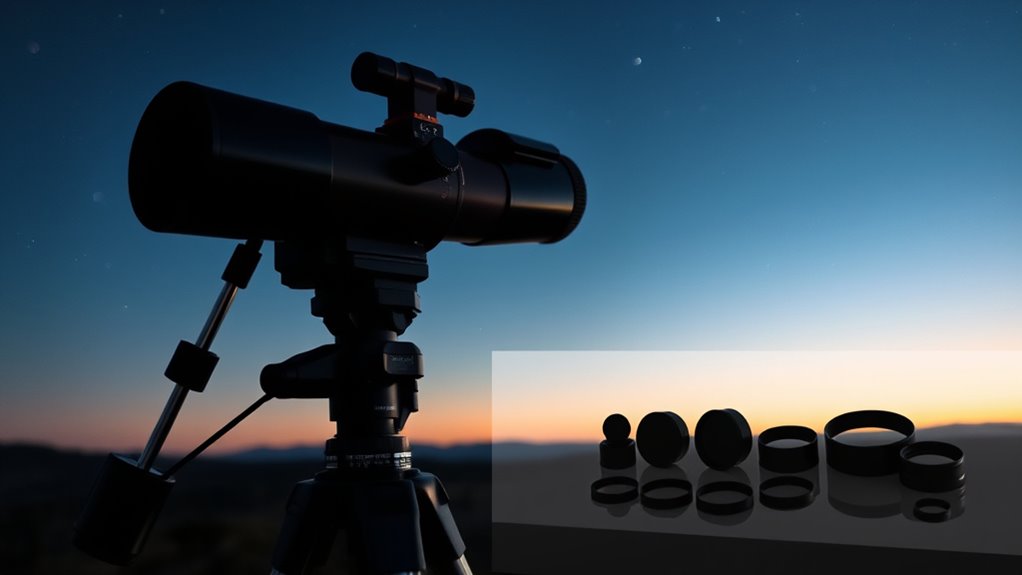
When selecting a field flattener, I consider how well it matches my telescope’s f-ratio and the quality of its coatings to guarantee ideal image clarity. I also check the back focus requirements and mounting options to make installation smooth and secure. Finally, I look at how effectively it flattens the field to avoid distortions across my images.
Compatibility With F-Ratios
Choosing a field flattener that matches your refractor telescope’s focal ratio is essential for achieving sharp, distortion-free images. Most flatteners are designed to perform best within specific focal ratio ranges, such as f/4 to f/8. Using a flattener outside its recommended f-ratio can cause star elongation or distortion at the edges, compromising image quality. Some models are adjustable or have settings for different f-ratios, offering greater flexibility. To guarantee ideal performance, always check the manufacturer’s specifications and confirm that the flattener suits your telescope’s focal ratio. Proper compatibility guarantees that the flat-field correction is effective, especially if you’re aiming for high-precision astrophotography or detailed imaging. Matching the flattener to your f-ratio is a key step toward sharp, clear images across the entire field.
Optical Coatings Quality
High-quality optical coatings play a essential role in guaranteeing your field flattener delivers peak performance. Fully multi-coated lenses enhance light transmission, making images brighter and more detailed, while reducing reflections that cause glare. These coatings also minimize internal ghosting, boosting contrast and color accuracy—crucial for astrophotography. Premium coatings protect lens surfaces from scratches, dust, and moisture, increasing durability and longevity. They guarantee minimal light loss across the visible spectrum, optimizing performance for various imaging wavelengths. The quality of these coatings directly impacts the effectiveness of the flattening process by maintaining consistent light quality across the entire field of view. Choosing a field flattener with superior optical coatings guarantees sharper, clearer images with enhanced contrast and color fidelity, elevating your observational and imaging experience.
Back Focus Requirements
Getting the back focus right is vital for achieving sharp, distortion-free images with your refractor telescope. The back focus distance is the space from your focuser or visual back to the camera sensor or film plane, directly affecting focus accuracy. Most field flatteners require a specific back focus, usually between 55mm and 109mm, to properly correct field curvature. If this distance isn’t correct, you may notice star elongation, blurring, or uneven focus across the image. Some flatteners come with adjustable spacers or precise mounting adapters, making it easier to achieve the exact back focus for your setup. Measuring and maintaining this distance precisely is essential for high-resolution astrophotography, especially with large sensors or sensitive cameras. Proper back focus ensures your images are sharp and free from distortion.
Mounting and Attachments
Ensuring your field flattener attaches securely and aligns precisely is essential for peak optical performance. First, check that it has compatible mounting threads like M48, T-ring, or other standard sizes, ensuring a snug fit with your telescope and camera. Confirm the flattener includes or supports adapters or extension tubes to achieve the recommended back focus distance for your setup. The mounting system should allow for easy attachment and precise alignment, helping maintain optimal image quality. Also, verify that the design accommodates your telescope’s hardware, such as dovetails or compression rings. Finally, consider whether the attachment method minimizes flexure and vibration during imaging, as stability is critical for sharp, consistent images across the entire field.
Image Flatness Effectiveness
When choosing a field flattener for your refractor telescope, understanding its effectiveness in producing a flat, distortion-free image is vital. The primary measure of success is how well it minimizes field curvature, ensuring stars remain sharp and round across the entire field. High-quality models incorporate advanced optical design features like ED glass and multiple lens elements, which notably enhance flattening performance. Proper back focus distance and correct attachment are essential; deviations can cause residual curvature and compromise flatness. To verify effectiveness, I regularly perform star tests and image analysis, ensuring the entire field remains uniformly sharp. Ultimately, a highly effective flattener delivers consistent image quality from center to edge, allowing for precise astrophotography and detailed viewing.
Ease of Installation
Choosing a field flattener that’s easy to install can save you time and frustration during setup. Look for models compatible with your refractor’s focal ratio, typically between f/5 and f/8, to ensure straightforward installation. Standard threading, like M48 or T-thread, makes attaching the flattener to your camera and telescope accessories simple and secure. A clear back focus distance guide helps you set the correct spacing between the camera sensor and the flattener, preventing focus issues. Opt for designs with user-friendly mounting features such as compression rings or plates, which allow quick, tool-free attachment. Additionally, choosing a flattener with minimal tools required for installation reduces setup time and makes adjustments more convenient, so you can spend more time capturing stunning images.
Frequently Asked Questions
How Do Field Flatteners Affect Image Brightness and Contrast?
Field flatteners can slightly reduce image brightness and contrast because they introduce additional glass elements into the optical path, which can cause some light loss. However, their main benefit is producing sharp, distortion-free images across the entire field of view. I find that while there might be a minor decrease in brightness, the improved clarity and flatness make my observations much more satisfying, especially for astrophotography.
Can Field Flatteners Be Used With Astrophotography Cameras Directly?
Yes, I can use field flatteners directly with astrophotography cameras. They’re designed to attach between my telescope and camera, ensuring a flat field for sharp, distortion-free images across the entire sensor. I just need to check compatibility with my camera’s mount and size. Once set up, I notice improved image quality, with stars appearing pinpoint from edge to edge, making my astrophotos clearer and more professional-looking.
Are There Specific Compatibility Issues With Different Telescope Brands?
I’ve learned that compatibility issues can be like trying to fit puzzle pieces—some brands fit perfectly, others need adapters. Different telescopes have unique thread sizes and optical designs, so I always double-check specifications before buying a field flattener. For example, my refractor worked seamlessly with a certain brand, but I needed an adapter for another. It’s essential to verify compatibility to avoid frustration and guarantee sharp, clear images.
How Do I Properly Clean and Maintain a Field Flattener?
To properly clean and maintain your field flattener, I recommend using a soft, lint-free microfiber cloth to gently wipe the glass surface. Avoid harsh chemicals; instead, opt for a small amount of lens cleaning solution or distilled water. Always handle it carefully to prevent scratches or smudges. Store it in a dust-free, dry place when not in use, and check regularly for any buildup or damage.
Do Field Flatteners Introduce Any Chromatic Aberration?
Yes, some field flatteners can introduce slight chromatic aberration, especially if they aren’t well-corrected or designed for specific wavelengths. I’ve noticed that quality flatteners made with high-quality glass and proper coatings minimize this issue. To avoid unwanted color fringing, I always choose flatteners specifically designed for my telescope’s focal length and optical system, which helps me get sharp, clear images without annoying chromatic distortions.
Conclusion
Choosing the right field flattener is like finding a perfect partner—both require compatibility and precision. While some deliver sharp images with ease, others demand more attention but offer greater rewards. Ultimately, it’s about balancing performance with your specific needs, much like balancing elegance with practicality. When you select thoughtfully, you’re not just improving images—you’re elevating your entire astrophotography experience, turning a simple telescope into a window to the universe’s finest details.
